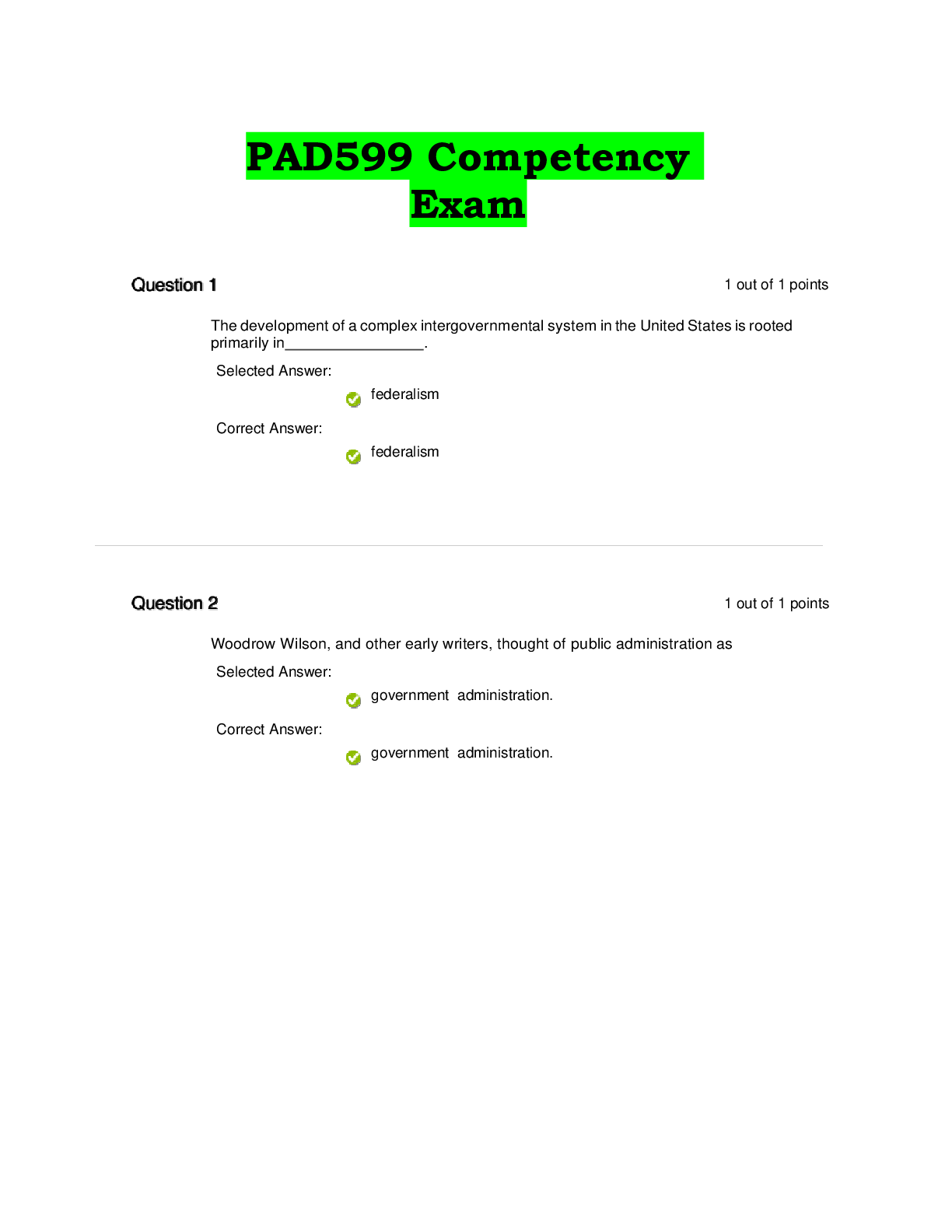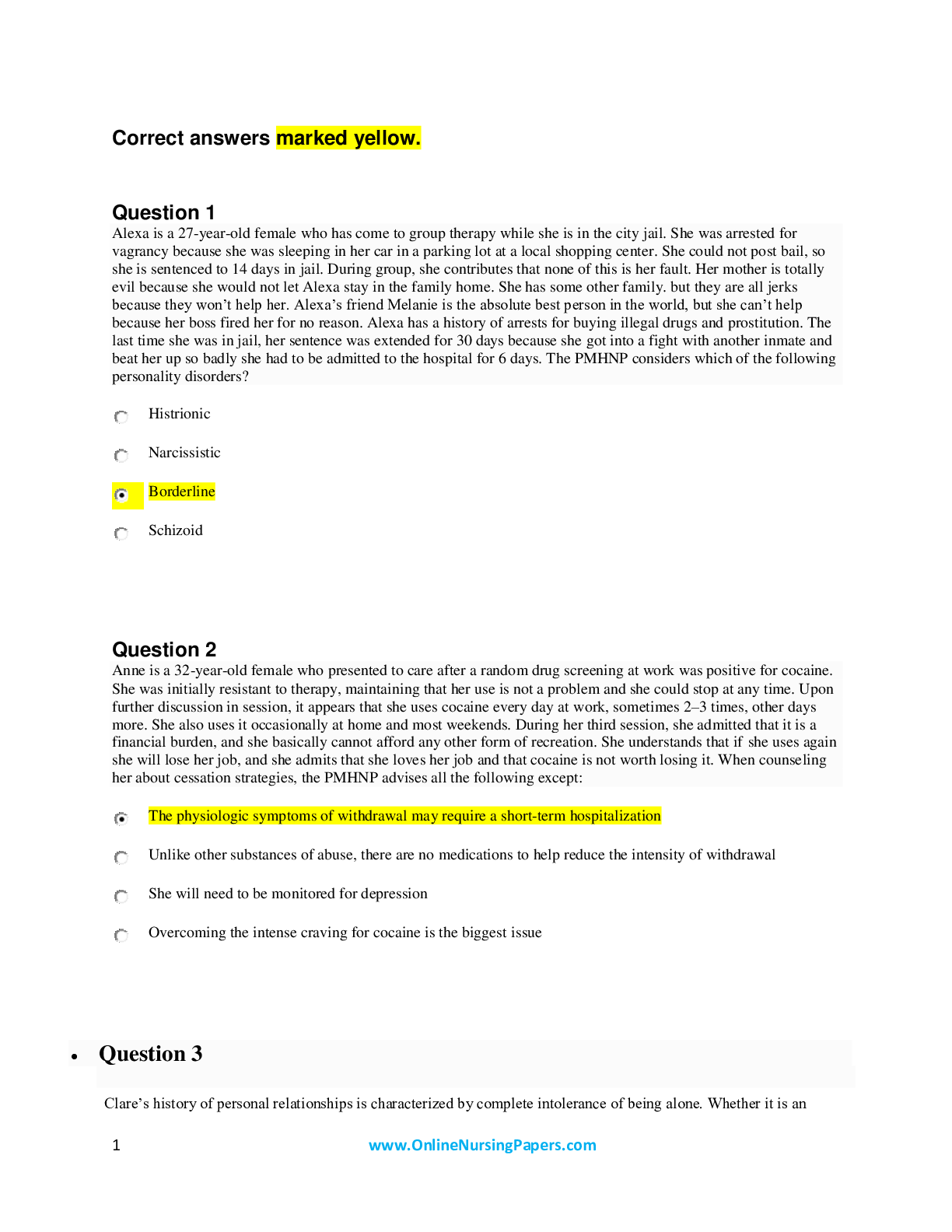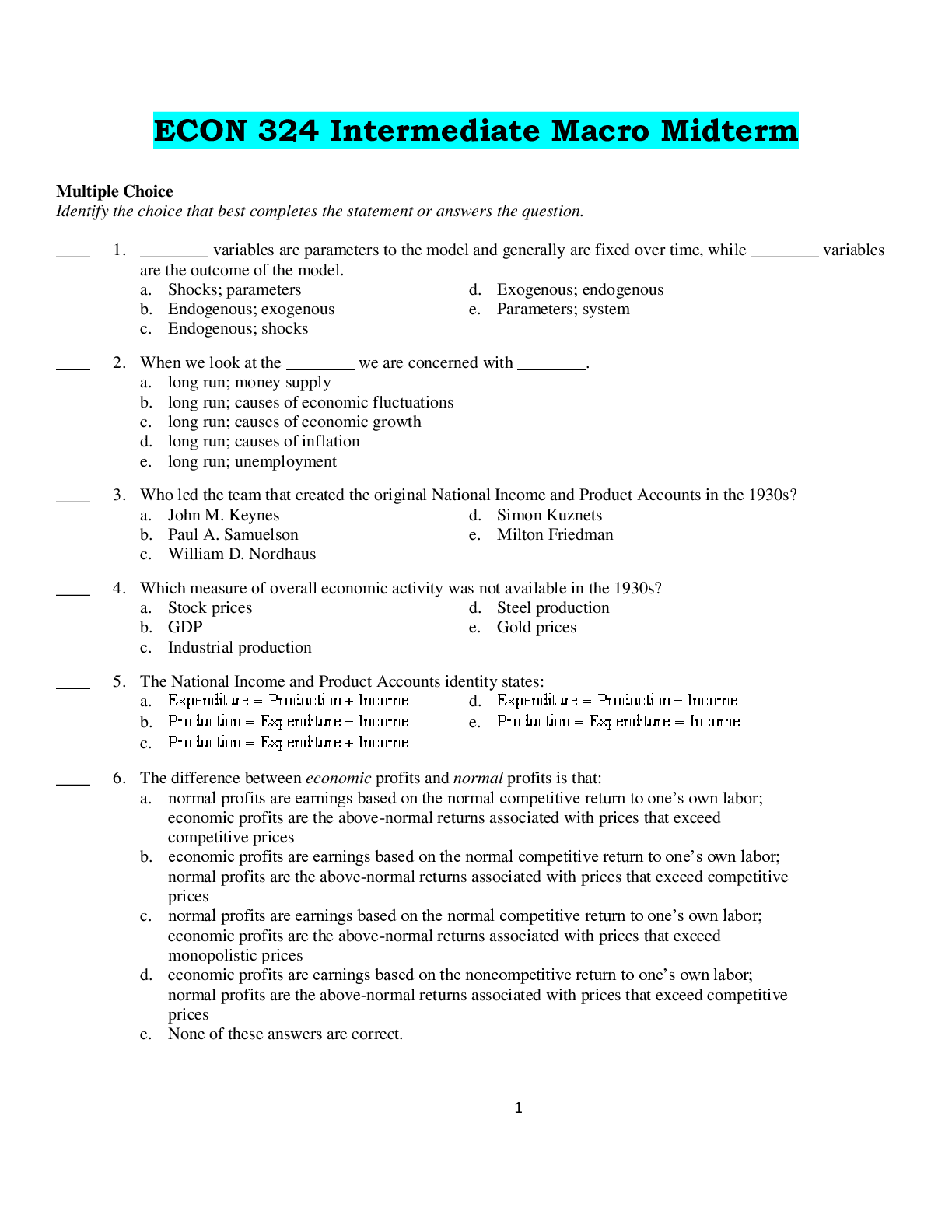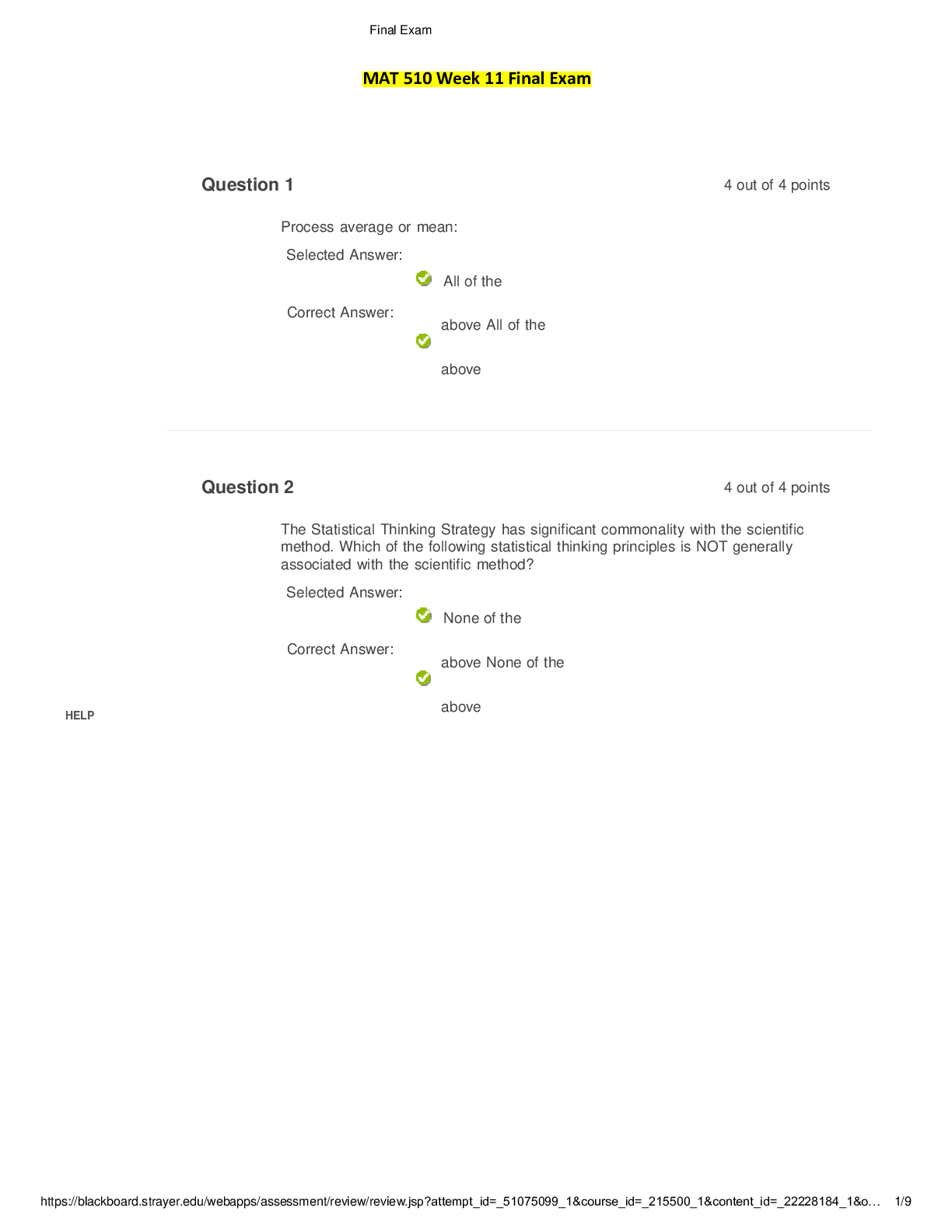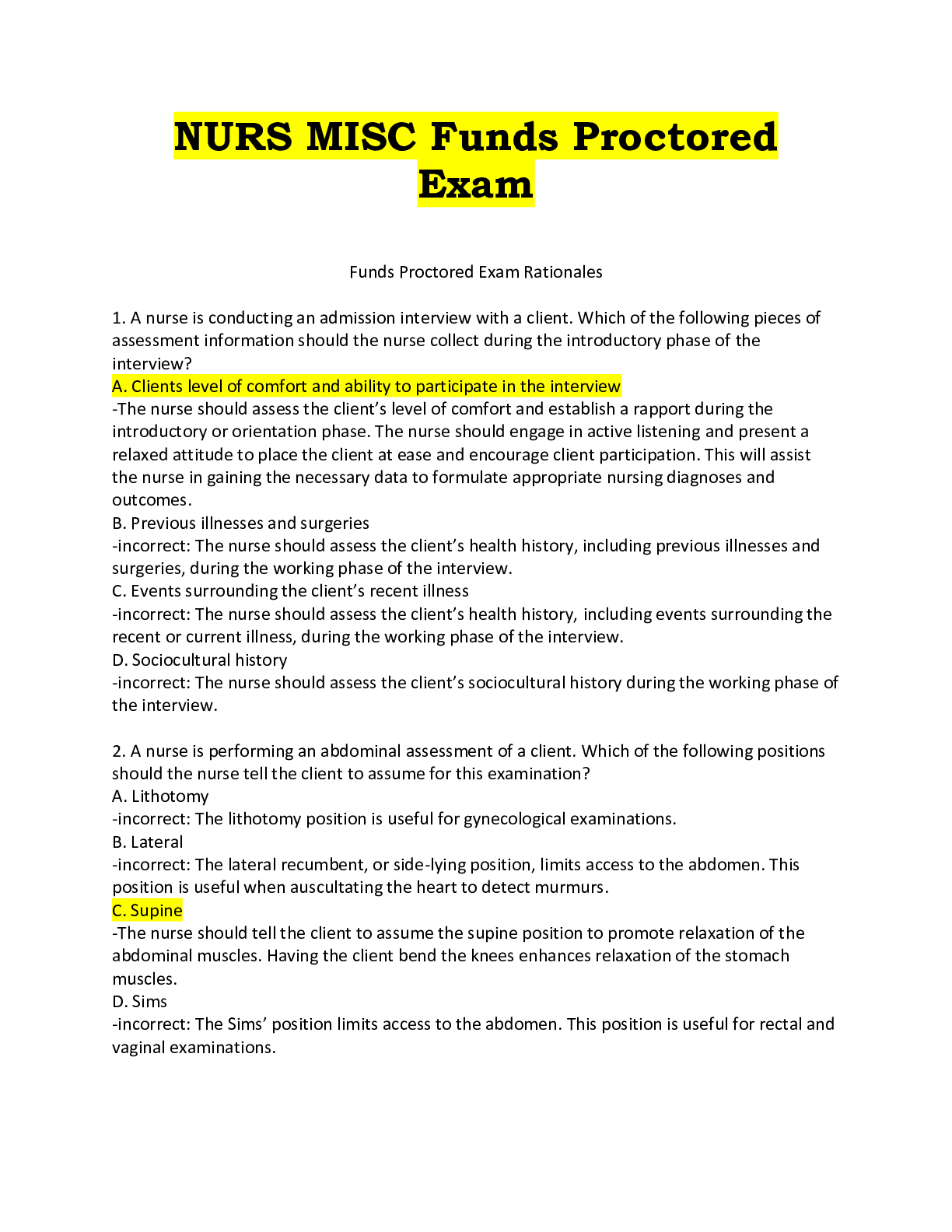E-Commerce > Final Exam Review > ECON10262&20262 ECON10262 - ECON20262 Macroeconomics 2 2019-20 2nd Semester (All)
ECON10262&20262 ECON10262 - ECON20262 Macroeconomics 2 2019-20 2nd Semester
Document Content and Description Below
ECON10262&20262 ECON10262 - ECON20262 Macroeconomics 2 2019-20 2nd Semester QUESTION 1 1. The president of Tunisia asks you to suggest an idea to improve the economy’s growth without worrying a... bout decreasing returns. You suggest: a. paying a competitive wage. b. offering firms an incentive to produce new ideas. c. placing a higher tax on firms. d. removing legal protection for firms. e. None of these answers is correct. 1.66 points QUESTION 2 1. If you decide to buy a house with an adjustable-rate mortgage (ARM), you are: a. taking on some of the lender’s inflation risk. b. increasing your mortgage payment. c. passing inflation risk to the lender. d. exposing yourself to inflation risk. e. reducing your inflation risk.1.66 points QUESTION 3 1. Which of the following does NOT count toward changes in the current GDP? a. A student pays for another year of tuition. b. You buy a used car from your parents. c. The local police station buys new squad cars. d. The Pentagon buys gasoline. e. None of these answers is correct. 1.66 points QUESTION 4 1. In the combined Solow-Romer model, the total output growth rate is greater than in the Romer model because: a. of a greater research share. b. capital depreciation is zero. c. of population growth. d. of capital accumulation. e. the saving rate is higher. 1.66 points QUESTION 5 1. Refer to the following figure when answering the following questions. Figure 7.3: Labor MarketIn March 2016, the United States imposed tariffs on steel imports from China. Using the labor market depicted in Figure 7.3, this would have the impact on the steel labor market of shifting labor: a. supply from to . b. demand from to . c. demand from to . d. supply from to . e. None of these answers is correct. 1.66 points QUESTION 6 1. If the nominal GDP rises by 6 percent and the price level rises by 3 percent, then the real GDP ________ by ________ percent. a. falls; 3 b. rises; 9 c. rises; 3d. falls; 9 e. None of these answers is correct. 1.66 points QUESTION 7 1. By how much does the current GDP rise in the following scenario? A real estate agent sells a house for $250,000 that the previous owners had purchased 10 years earlier for $90,000. The real estate agent earns a commission of $10,000. a. $90,000 b. $260,000 c. $250,000 d. $10,000 e. $160,000 1.66 points QUESTION 8 1. As an economist working at the International Monetary Fund, you are given the following data for Burundi: observed per capita GDP, relative to the United States, is 0.01; predicted per capita GDP, given by , is 0.18. What is total factor productivity? a. 18.00 b. 0.44 c. 0.00 d. 0.06 e. 0.98 1.66 points QUESTION 91. For efficient allocation of resources ________ and ________ must be equal across firms. a. nominal wages; real wages b. the marginal product of capital; the marginal product of labor c. unemployment must be equal to its natural rate; wages d. the capital stock; the labor stock e. net exports should be zero; the marginal product of capital 1.66 points QUESTION 10 1. Empirically, a large amount of evidence suggests that money neutrality ________, but changes in money supply ________. a. does not hold in the long run; can have real effects in the short run b. holds in the short run; do not affect nominal variables c. does not hold in the long run; have an effect on unemployment in the long run d. holds in the long run; can have real effects in the short run e. holds in the short run; can have real effects in the long run 1.66 points QUESTION 11 1. In the combined Solow-Romer model, an exogenous increase in the saving rate: a. immediately decreases the growth rate of per capita output, which eventually accelerates to a higher rate. b. immediately increases the growth rate of per capita output, which eventually slows to its previous rate. c. has no impact on the growth rate or level of per capita output.d. immediately decreases the per capita output, but the growth rate does not change. e. increases the growth rate of per capita income, but eventually the economy reaches a new steady-state level of per capita output. 1.66 points QUESTION 12 1. A central lesson of the Solow model is that: a. the initial capital stock plays a large part in long-run economic growth. b. capital accumulation is the only engine of long-run per capita economic growth. c. consumption is the only engine of short-run per capita economic growth. d. capital accumulation cannot serve as the engine of long-run per capita economic growth. e. saving rates serve as the engine of long-run per capita economic growth. 1.66 points QUESTION 13 1. With unanticipated inflation: a. creditors with indexed contracts gain, because they receive more than they contracted for in nominal terms. b. debtors with an indexed contract are hurt, because they pay more than they contracted for in real terms. c. debtors with an indexed contract are hurt, because they pay more than they contracted for in nominal terms. d. debtors with an unindexed contract lose, because they pay exactly what they contracted for in nominal terms. e. creditors are hurt unless they have an indexed contract, because they get less than they expected in real terms. 1.66 points QUESTION 141. Suppose you are given the data for Brazil and Portugal. In Brazil, the saving rate is 0.1 and the depreciation rate is 0.1, while in Portugal the saving rate is 0.2 and the depreciation rate is 0.1. Using the Solow model, you conclude that in the steady state: a. Portugal has a higher capital-output ratio than Brazil. b. Brazil has a higher level of output than Portugal. c. Portugal has a higher level of output than Brazil. d. Brazil has a higher capital-output ratio than Portugal. e. Portugal and Brazil have the same capital-output ratio. 1.66 points QUESTION 15 1. Refer to the following table when answering the following questions. Table 2.4: U.S. and Eurozone (18 Economies) Nominal GDP in 2015 2015 Eurozone nominal GDP (€ billions) €10,455 U.S. nominal GDP ($ billions) $18,036 Dollar/euro exchange rate $1.10/€1 PEZ/PUS 0.85 2. Consider Table 2.4. The value of the eurozone nominal GDP in U.S. dollars adjusted for price differences is ________ billion. $9,775 $13,530 $11,182$8,079 $16,863 1.66 points QUESTION 16 1. You are the head of the central bank and you want to maintain 2 percent long-run inflation. Using the quantity theory of money, if real GDP growth is 4 percent and velocity is constant, you suggest a: a. 4 percent money supply growth. b. 6 percent interest rate. c. 2 percent money supply growth. d. 0 percent money supply growth. e. None of these answers is correct. 1.66 points QUESTION 17 1. The unemployment rate is defined as the ratio of: a. unemployed to employed members of the labor force. b. all adults not working to the total population. c. discouraged workers to the total population. d. unemployed members of the labor force to the total population. e. unemployed members of the labor force to the total labor force. 1.66 points QUESTION 18 1. One consequence of wage rigidity is:a. lower rates of unemployment. b. less labor market volatility. c. labor market stability. d. a lower unemployment rate. e. None of these answers is correct. 1.66 points QUESTION 19 1. The difference between economic profits and normal profits is that: a. normal profits are earnings based on the normal competitive payments to the factors used in production; economic profits are the above-normal returns associated with prices that exceed competitive prices. b. economic profits are earnings based on the normal competitive payments to the factors used in production; normal profits are the above-normal returns associated with prices that exceed competitive prices. c. normal profits are earnings based on the normal competitive payments to the factors used in production; economic profits are the above-normal returns associated with prices that exceed monopolistic prices. d. economic profits are earnings based on the noncompetitive payments to the factors used in production; normal profits are the above-normal returns associated with prices that exceed competitive prices. e. None of these answers is correct. 1.66 points QUESTION 20 1. As an economist working at the International Monetary Fund, you are given the following data for Burundi: observed per capita GDP, relative to the United States, is 0.01; predicted per capita GDP, given by , is 0.18. What is total factor productivity? a. 0.00b. 0.06 c. 0.98 d. 18.00 e. 0.44 1.66 points QUESTION 21 1. In the Romer model, if Canada and Taiwan have the same fraction of researchers and the same knowledge efficiency parameter but Canada’s population is larger, then: a. Canada has a higher per capita output growth rate. b. each country’s per capita output grows at the same rate. c. Taiwan has a higher per capita output growth rate. d. Canada’s level of income is greater than Taiwan’s. e. Canada has higher per capita income than Taiwan. 1.66 points QUESTION 22 1. Suppose the payments to capital and labor are ( w* L*)/ Y* = 2/3 and ( r* K*)/ Y* = 1/3, respectively. One implication of this result is: a. . b. . c. . d. . e. . 1.66 pointsQUESTION 23 1. Refer to the following figure when answering the following questions. Figure 5.4: Solow Diagram Consider the Solow model exhibited in Figure 5.4. Which of the following is/are true? i. For any single country, the movement from point a to b is due to an increase in the saving rate, s 1 > s 2. ii. For any single country, the movement from point c to b is due to an increase in capital stock for the saving rate, s 2. iii. If s 1 and s 2 stand for the saving rates in Countries 1 and 2, respectively, Country 2 has a lower saving rate. a. i, ii, and iii b. i c. ii d. i and ii e. iii 1.66 points QUESTION 24 1. Because of the dynamics of the workforce, for example, whether workers become discouraged when there are changes in the economy:a. the unemployment rate is not necessarily an accurate gauge of the labor market. b. the unemployment rate is a precise gauge of the labor market. c. one should only consider the employment-population ratio rather than the unemployment rate. d. at times the labor demand curve is upward sloping. e. None of these answers is correct. 1.66 points QUESTION 25 1. Suppose k, l, and A grow at constant rates given by and What is the growth rate of y if a. b. c. d. e. 1.66 points QUESTION 26 1. Consider the simplified payment system to compensate the victims of 9/11 for lost lifetime earnings: • The family of a 65-year-old service worker earning $10,000 a year receives $300,000 in compensation. • The family of a 30-year-old bond trader earning $175,000 a year receives $4.35 million. Which statement most accurately describes the difference in the payments between the service worker and the bond trader? a. The present value of the bond trader’s lifetime income is greater than the service worker’s.b. Because of her age, the bond trader had less savings to rely on, so her family received more compensation. c. The future value of the bond trader’s lifetime income is less than the service worker’s. d. Such a discrepancy in compensation would never be the case. e. None of these answers is correct. 1.66 points QUESTION 27 1. In the Romer model, with decreasing returns to the knowledge sector: a. more researchers produce more ideas, raising the long-run level of per capita income. b. the number of researchers is irrelevant to long-term per capita income. c. more researchers cause the knowledge stock to contract. d. more researchers produce fewer ideas, raising the long-run growth rate of per capita income. e. more researchers produce more ideas, raising the long-run growth rate of per capita income. 1.66 points QUESTION 28 1. In the standard production model’s production function, the productivity parameter enters the equation with an exponent of one, while in the Solow model’s equation for the steady-state stock of capital it is greater than one because: a. there is no productivity parameter in the production function model. b. the endogenous level of the capital stock itself depends on productivity. c. the productivity measure is zero in the production function model. d. the exogenous level of the capital stock itself depends on productivity. e. the productivity measure is negative in the Solow model.1.66 points QUESTION 29 1. The coordination problem is difficult to solve because: a. policymakers cannot make unified decisions. b. aggregate price-setting behavior has built-in inflation inertia. c. individual price-setting behavior economywide has built-in inflation inertia. d. central banks are controlled by many different interests. e. All of these answers are correct. 1.66 points QUESTION 30 1. Figure 4.6: Production Function Consider the two production functions in Figure 4.6, representing two countries. Which of the following is true? i. At points a and b, each country has the same per capita capital stock but different factor productivity. ii. Points a and c represent the same country but with different factor productivity. iii. Points b and d represent the same country but with different stock of per capita capital.a. i and ii b. i only c. ii only d. iii only e. i and iii 1.66 points Click Save and Submit to save and submit. Click Save All Answers to save all answers. Save and Submit [Show More]
Last updated: 1 year ago
Preview 1 out of 15 pages
Instant download

Buy this document to get the full access instantly
Instant Download Access after purchase
Add to cartInstant download
Reviews( 0 )
Document information
Connected school, study & course
About the document
Uploaded On
May 15, 2021
Number of pages
15
Written in
Additional information
This document has been written for:
Uploaded
May 15, 2021
Downloads
0
Views
53



